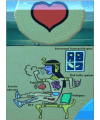Impact of Using a 3D Visual Metaphor Serious Game to Teach History-Taking Content to Medical Students: Longitudinal Mixed Methods Pilot Study
- PMID: 31573895
- PMCID: PMC6788337
- DOI: 10.2196/13748
Impact of Using a 3D Visual Metaphor Serious Game to Teach History-Taking Content to Medical Students: Longitudinal Mixed Methods Pilot Study
Abstract
Background: History taking is a key component of clinical practice; however, this skill is often poorly performed by students and doctors.
Objective: The study aimed to determine whether Metaphoria, a 3D serious game (SG), is superior to another electronic medium (PDF text file) in learning the history-taking content of a single organ system (cardiac).
Methods: In 2015, a longitudinal mixed methods (quantitative and qualitative) pilot study was conducted over multiple sampling time points (10 weeks) on a group of undergraduate medical students at The University of Auckland Medical School, New Zealand. Assessors involved in the study were blinded to group allocation. From an initial sample of 83, a total of 46 medical students were recruited. Participants were assigned to either a PDF group (n=19) or a game group (n=27). In total, 1 participant left the PDF group after allocation was revealed and was excluded. A total of 24 students in the game group and 14 students in the PDF group completed follow-up 7 weeks later. Using an iterative design process for over a year, with input from a variety of clinical disciplines, a cardiac history-taking game and PDF file were designed and informed by Cognitive Load Theory. Each group completed its intervention in 40 min. A total of 3 levels of Kirkpatrick training evaluation model were examined using validated questionnaires: affective (perception and satisfaction), cognitive (knowledge gains and cognitive load), and behavioral attitudes (Objective Structured Clinical Exam) as well as qualitative assessment. A priori hypotheses were formulated before data collection.
Results: Compared with baseline, both groups showed significant improvement in knowledge and self-efficacy longitudinally (P<.001). Apart from the game group having a statistically significant difference in terms of satisfaction (P<.001), there were no significant differences between groups in knowledge gain, self-efficacy, cognitive load, ease of use, acceptability, or objective structured clinical examination scores. However, qualitative findings indicated that the game was more engaging and enjoyable, and it served as a visual aid compared with the PDF file.
Conclusions: Students favored learning through utilization of an SG with regard to cardiac history taking. This may be relevant to other areas of medicine, and this highlights the importance of innovative methods of teaching the next generation of medical students.
Keywords: clinical competence; instructional technology; learning; memory; metaphor; retention; video games.
©Hussain Alyami, Mohammed Alawami, Mataroria Lyndon, Mohsen Alyami, Christin Coomarasamy, Marcus Henning, Andrew Hill, Frederick Sundram. Originally published in JMIR Serious Games (http://games.jmir.org), 26.09.2019.
Conflict of interest statement
Conflicts of Interest: None declared.
Figures







References
-
- Nardone DA, Reuler JB, Girard DE. Teaching history-taking: where are we? Yale J Biol Med. 1980;53(3):233–50. http://europepmc.org/abstract/MED/7405275 - PMC - PubMed
-
- Lipkin Jr M, Frankel RM, Beckman HB, Charon R, Fein O. Performing the interview. In: Lipkin MJ, Putnam SM, Lazare A, Carroll JG, Frankel RM, Keller A, Klein T, Williama PK, editors. The Medical Interview. New York: Springer; 1995. pp. 65–82.
LinkOut - more resources
Full Text Sources

